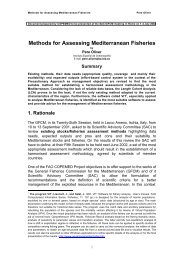Cours sur les méthodes d'évaluation acoustique ... - Fao - Copemed
Cours sur les méthodes d'évaluation acoustique ... - Fao - Copemed
Cours sur les méthodes d'évaluation acoustique ... - Fao - Copemed
Create successful ePaper yourself
Turn your PDF publications into a flip-book with our unique Google optimized e-Paper software.
Cartesian coordinate system 4These conventional names are often used in other domains, such as physics and engineering. However, other lettersmay be used too. For example, in a graph showing how a pres<strong>sur</strong>e varies with time, the graph coordinates may bedenoted t and P. Each axis is usually named after the coordinate which is mea<strong>sur</strong>ed along it; so one says the x-axis,the y-axis, the t-axis, etc.Another common convention for coordinate naming is to use subscripts, as in x , x , ... x for the n coordinates in an1 2 nn-dimensional space; especially when n is greater than 3, or variable. Some authors (and many programmers) preferthe numbering x , x , ... x . These notations are especially advantageous in computer programming: by storing the0 1 n−1coordinates of a point as an array, instead of a record, one can use iterative commands or procedure parametersinstead of repeating the same commands for each coordinate.In mathematical illustrations of two-dimensional Cartesian systems, the first coordinate (traditionally called theabscissa) is mea<strong>sur</strong>ed along a horizontal axis, oriented from left to right. The second coordinate (the ordinate) is thenmea<strong>sur</strong>ed along a vertical axis, usually oriented from bottom to top.However, in computer graphics and image processing one often uses a coordinate system with the y axis pointingdown (as displayed on the computer's screen). This convention developed in the 1960s (or earlier) from the way thatimages were originally stored in display buffers.For three-dimensional systems, mathematicians usually draw the z axis as vertical and pointing up, so that the x and yaxes lie on an horizontal plane. There is no prevalent convention for the directions of these two axes, but theorientations are usually chosen according to the right-hand rule. In three dimensions, the names "abscissa" and"ordinate" are rarely used for x and y, respectively. When they are, the z-coordinate is sometimes called theapplicate.The words abscissa, ordinate and applicate are sometimes used to refer to coordinate axes rather than values. [4]Quadrants and octantsThe axes of a two-dimensional Cartesian system dividethe plane into four infinite regions, called quadrants,each bounded by two half-axes. These are oftennumbered from 1st to 4th and denoted by Romannumerals: I (where the signs of the two coordinates are I(+,+), II (−,+), III (−,−), and IV (+,−). When the axes aredrawn according to the mathematical custom, thenumbering goes counter-clockwise starting from theupper right ("northeast") quadrant.Similarly, a three-dimensional Cartesian system defines adivision of space into eight regions or octants, accordingto the signs of the coordinates of the points. The octantwhere all three coordinates are positive is sometimescalled the first octant; however, there is no establishednomenclature for the other octants. The n-dimensionalgeneralization of the quadrant and octant is the orthant.The four quadrants of a Cartesian coordinate system.
















